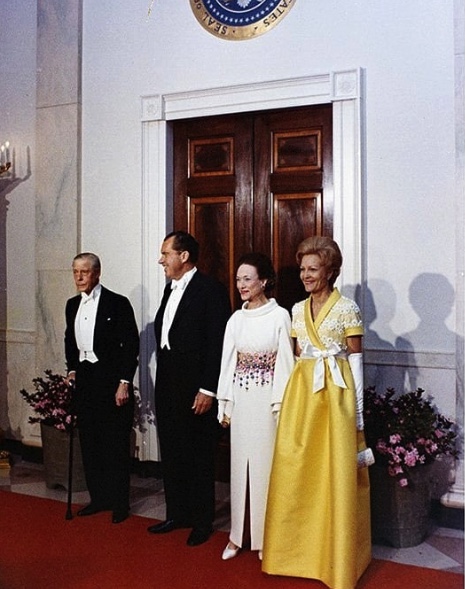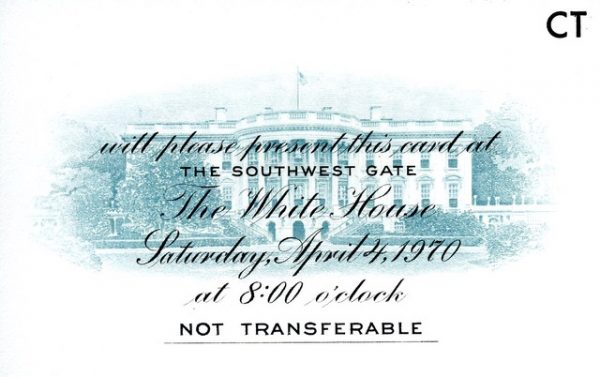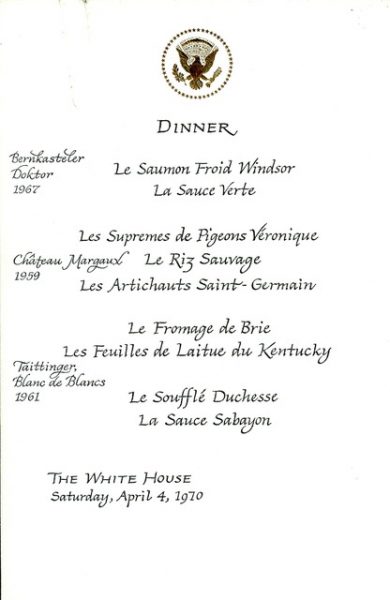
On April 4, 1970, President Richard Nixon and First Lady Pat Nixon hosted a white-tie dinner for the Duke and Duchess of Windsor, but the friendship between the couples started many years before. In 1964, the Nixons attended a tea in the duke’s honor at the Waldorf-Astoria hotel in New York, and in 1966, when the royals were living in Paris, they hosted a formal dinner party for their American friends. After her father won the presidency, Julie Nixon Eisenhower suggested that he and her mother return the duke and duchess’s kindness by hosting them at the White House.

Although he was no longer Edward VIII, King of England — he’d abdicated the throne more than three decades earlier to marry his American socialite bride, Wallis Simpson — the duke was treated just as royally. He hadn’t been at the White House since June 1, 1942, when President Franklin D. Roosevelt and First Lady Eleanor Roosevelt held a luncheon for him, so the duke was happy to be back in Washington, D.C.
President Nixon greeted the royal couple at the North Portico, then escorted them to the Yellow Oval Room, where Mrs. Nixon, Tricia Nixon, Julie and David Eisenhower, and Ambassador Emil Mosbacher and Patricia Mosbacher were waiting. They all descended down the Grand Staircase, paused for official photos, and headed to the East Room to meet the invited guests.

Everyone dressed to the nines. One paper wrote that the women’s dresses and jewels were “almost beyond belief.” The first lady wore a yellow silk ball gown by Sarmi, with a bodice of daisy lace accented by tiny chalk beads, full skirt, and white satin ribbon at the waistline. The duchess wore a long-sleeved white silk crepe gown with jeweled belt by Givenchy and ruby earrings encircled with two rows of diamonds.
The duke’s abdication didn’t dampen enthusiasm for the affair, and many people clamored for an invitation. In fact, the duke told White House Social Secretary Lucy Winchester that he heard that “his friends” had been giving her a hard time, and he smilingly emphasized the word “friends.” Guests included the duke’s golfing partner, Loel Guinness, and his wife, Gloria; Charles Lindbergh and his wife, Anne; Arnold Palmer and his wife, Winifred; and Fred Astaire. Also in attendance were Alice Roosevelt Longworth, daughter of President Theodore Roosevelt, and John Coolidge, son of President Calvin Coolidge.
Dinner took place in the State Dining Room, at a large, E-shaped table, which was the traditional arrangement prior to the Kennedy administration. Guests feasted on cold salmon, supreme of pigeon with wild rice and artichokes, Brie salad, and souffle duchesse with sabayon. The menu, written in French with the presidential seal on top, was a keepsake. Even Julie Eisenhower participated in the White House tradition of collecting autographs; on her menu card were signatures from Lindbergh, Longworth, and Coolidge.
In his toast, the duke spoke of his 73-year-old wife, who was born in Baltimore. “I have had 30 years of complete devotion and companionship — something I cherish above all else,” he said. He also referenced the shared history of England and America, as most royals do. “I feel more kindly about the White House than did many of my countrymen when they were here in 1812,” he joked.
After dinner, guests proceeded to the parlors for coffee, liqueurs, and cigars before settling into the East Room for a set by Bobby Short. The legendary pianist-singer from the Carlyle Hotel had been one of the duke’s favorite performers for 20 years. As Short played songs by Cole Porter — “I’ve a Shooting Box in Scotland,” “I’m Throwing a Ball Tonight,” and “Black and White Baby of Mine” — the duke reportedly tapped his cane on the floor and swung in his seat to the music. And when Short sang “Bye, Bye Blackbird,” the duke’s favorite, he raised his hands in applause. Also brought in for the program were The Young Saints, a group of 27 high school and college students from the Los Angeles area, whose performance ranged from Bach to rock to a rousing rendition of “When the Saints Come Marching In.”
When the entertainment concluded, President and Mrs. Nixon walked the Duke and Duchess of Windsor to the North Portico, where a limousine was waiting to take them across the street to Blair House, the president’s official guest house. However, that was not a signal for the crowd to go home. Julie and David Eisenhower and scores of other guests remained, socializing and dancing to the music of a Marine combo. At 12:30 a.m., Short sat down at the White House Steinway grand piano, and, with help from Richard Sheridan on drums and Beverly Peer on bass, played for another 30 to 45 minutes.
The gala was nothing short of a huge success for the newly elected president and his first lady. United Press International described the event as “a swinging party” and “a star-studded affair with VIPs and jet-set socialites.” Social scribe Betty Beale reported in the Evening Star, “The dinner was such a perfect combination of pep, pomp, and prominence and so beautifully done that the ultra-social American guests left praising and proud.”
But for the royal honorees, it was a more sentimental affair. “What a warm, wonderful evening,” the duke said.


